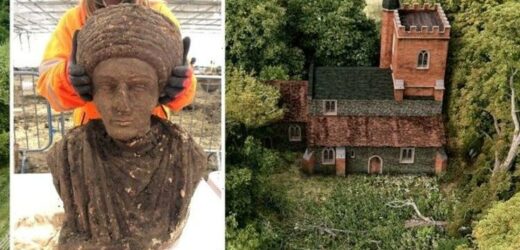HS2 archaeologists make rare discovery in Buckinghamshire
We use your sign-up to provide content in ways you’ve consented to and to improve our understanding of you. This may include adverts from us and 3rd parties based on our understanding. You can unsubscribe at any time. More info
The Norman Conquest of 1066 saw the invasion and occupation of England by an army of thousands of Normans, Bretons, Flemish and French troops under the leadership of the Duke of Normandy, later titled William the Conqueror. After winning the Battle of Hastings, his army captured the south east and seized Dover and Winchester, before advancing to London. Though many English people were not happy about the change in leadership, William was crowned king on Christmas Day of the same year.
Under Norman rule, England changed enormously, with long lasting effects including land ownership, the building of castles and the introduction of Norman laws.
The parish of Stoke Mandeville stood in the way of William’s rolling conquest, and it was here that an isolated church, surrounded by fields and riddled in mystery, stood.
Built around 1080, the Church of St Mary’s was located in a damp, isolated spot around half a mile from the village.
It was neglected and fell into ruin in the 19th Century when a new, more convenient church was built. It was eventually demolished.


Almost 1,000 years after it was built, the government’s HS2 railway line now needs to pass through the ruin, with a team of archaeologists having set to work excavating thousands of graves, preserving thousands more artefacts and unravelling the mystery of the church’s history.
Dr Rachel Wood, the site’s lead archaeologist, told the BBC’s recent ‘Digging for Britain’ documentary that her team are determined to answer the question as to why there is a church in the middle of an unoccupied field.
The site first made headlines when it was revealed that around 3,000 skeletons needed to be removed from its grounds, and during the recent excavations, Dr Wood’s team discovered evidence of Iron Age, Bronze Age and even Roman activity.
But after this last period there was a gap of more than 600 years.

Dr Wood said: “We don’t have any evidence for any Saxon activity at all at the minute.”
However, on further investigation, wishes were fulfilled when the team came across the remains of an Anglo-Saxon church buried beneath the site of the old St Mary’s Church.
The Norman church was built on a light grey compacted foundation band, laid down by the Normans, so anything beneath would have been pre-Norman.
Archaeologists found flint walls in a square shape beneath the Norman levels, which were enclosed by a circular boundary ditch, alongside a small number of associated burials.
DON’T MISS:
Antarctica discovery offered stunning evidence for life [INSIGHT]
Archaeology: ‘Unexpected’ Solent discovery rewrites farming history [BREAKTHROUGH]
Yellowstone eruption warning: Human brains could be ‘popped apart’ [QUOTES]

The flint foundations were around one metre wide, leading the team to conclude it would likely have been a tall structure with a small footprint.
Its footprint is similar to a still-standing Saxon church in Barton-upon-Humber, a town just over the Humber Estuary from Hull.
In September 2021, Dr Wood said that the site was an “outstanding” discovery, and explained: “To have so much of it remaining, including the walls and even some flooring, will provide a great deal of information about the site prior to the construction of the Norman church in 1080 AD.
“The discovery of this pre-Norman, possible Saxon Church is a once in a career opportunity for archaeologists and will provide a much greater understanding of the history of Stoke Mandeville.”

While excavating the circular ditch around the square foundations, they made further discoveries, uncovering the shoulders and heads from two life-sized roman busts in a darker, organic layer of the soil.
The ditches had multiple pots of cremated remains, a stunning glass urn, and an extraordinary headless skeleton with leg injuries that suggested a sudden, violent end.
Prof Roberts said: “It’s all beyond the archaeologists’ wildest expectations.”
Archaeologist Guy Hunt told the documentary: “Those sculptures, that is so rare.
“To find that sort of thing in an archaeological context, it’s really, really rare.”
Dr Wood added: “You would be extremely lucky if you ever found anything like that, let alone more than one of them.”
Evidence of a nearby Roman settlement has allowed archaeologists to build a much clearer picture of how the Buckinghamshire landscape might have looked more than 1,000 years ago.
The artefacts are now being divided up and sent to specialists for further analysis.
Source: Read Full Article


